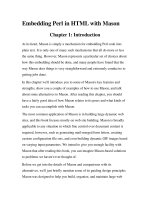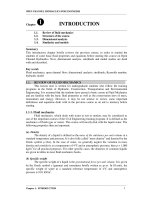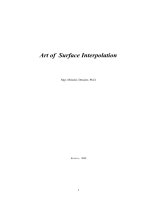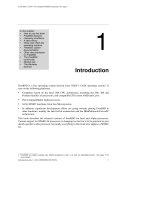Chapter 1 introduction
Bạn đang xem bản rút gọn của tài liệu. Xem và tải ngay bản đầy đủ của tài liệu tại đây (144.23 KB, 20 trang )
VIETNAM NATIONAL UNIVERSITY – HO CHI MINH CITY
UNIVERSITY OF TECHNOLOGY
FACULTY OF CHEMICAL ENGINEERING
Chemical Reaction Engineering
(Homogeneous Reactions in Ideal Reactors)
Mai Thanh Phong, Ph.D.
FCE – HCMC University of Technology
Chemical Reaction Engineering
References
1. Octave Levenspiel, “Chemical Reaction Engineering”, John Wiley&Sons, 2002.
2. H. Scot Foggler, “Elements of Chemical Reaction Engineering”,International
students edition, 1989.
3. E.B.Nauman, “Chemical Reactor Design”, John Wiley & sons, 1987.
4. Stanley M. Walas, “Reaction Kinetics for Chemical Engineers”,Int. Student
Edition, 1990.
5. Coulson & Richardsons, “Chemical Engineering – Vol 6”,Elsevier, 1979.
6. Richard M. Felder, “Elementary Principles of Chemical Processes”, John Wiley &
sons, 2000.
Mai Thanh Phong - HCMUT
Chemical Reaction Engineering
Apr 28, 2023
2
Chapter 1. Introduction
•
Topic of the lecture „Chemical Reaction Engineering“ is the quantitative
assessment of chemical reactions. The selection of suitable reactor types and
their design will be discussed.
•
Reactor design uses information, knowledge, and experience from a variety of
areas: thermodynamics, chemical kinetics, fluid mechanics, heat transfer, mass
transfer, and economics. Chemical reaction engineering is the synthesis of all
these factors with the aim of properly designing a chemical reactor.
•
Thermodynamics tell us in which direction a reaction system will develop and
how far it is from its equilibrium state.
•
Analyses of kinetics provide information about the rate with which the system will
approach equilibrium.
Mai Thanh Phong - HCMUT
Chemical Reaction Engineering
Apr 28, 2023
3
Chapter 1. Introduction
I.
Basic Parameter
Description of the amount of a substance i:
Number of moles:
mi
ni
Mi
Mi = molecular weight
Molar concentration:
ni
ci
V
V = volume
Mole fraction:
ni
xi
nj
j
Mai Thanh Phong - HCMUT
Chemical Reaction Engineering
Apr 28, 2023
4
Chapter 1. Introduction
Progress of chemical reactions:
Conversion:
ni 0 ni
Xi
ni 0
If V = const:
ci 0 ci
Xi
ci 0
Extent of reaction:
ni ni 0
i
Performance criteria:
Productivity:
Mai Thanh Phong - HCMUT
produced amount of product P
n P
operating time
Chemical Reaction Engineering
Apr 28, 2023
5
Chapter 1. Introduction
II. Stoichiometry of chemical reactions:
Stoichiometry is based on mass conservation and thus quantifies general laws
that must be fulfilled during each chemical reaction.
Starting point of a quantitative analysis is the following formulation of a chemical
reaction:
N
A 0
i 1
i
i
This equation describes the change of the number of moles of N components
A1, A2, ... AN. The νi are the stoichiometric coefficients of component i. They have
to be chosen in such a way that the moles of all elements involved in the chemical
reaction remain constant.
A convention is that reactants have negative stoichiometric coefficients and products
have positive stoichiometric coefficients.
Mai Thanh Phong - HCMUT
Chemical Reaction Engineering
Apr 28, 2023
6
Chapter 1. Introduction
As an example the stoichiometric equation for the oxidation of carbon monoxide
is given by:
2CO + O2 → 2CO2
with
νCO = -2, vO2 = -1, vCO2 = 2
To calculate changes in the mole number of a component i due to reaction, the
following balance has to be respected:
ni ni 0 i
From this equation results the important stoichiometric balance:
ni 0 ni ni nk 0 nk nk
i
i
k
k
Using the conversion X of a component k, the above equation becomes:
i
ni ni 0
nk 0 X k
k
Mai Thanh Phong - HCMUT
Chemical Reaction Engineering
Apr 28, 2023
7
Chapter 1. Introduction
III. Chemical thermodynamics:
Chemical thermodynamics deal with equilibrium states of reaction system. This
Section will concentrate on the following two essential areas:
a) The calculation of enthalpy changes connected with chemical reactions, and
b) The calculation of equilibrium compositions of reacting systems.
3.1 Enthalpy of reaction
The change of enthalpy caused by a reaction is called reaction enthalpy ∆HR.
This quantity can be calculated according to the following equation:
N
H R i H Fi
i 1
∆HFi is the enthalpy of formation of component i
∆HR < 0, the reaction is exothermic
∆HR > 0, the reaction is endothermic
Mai Thanh Phong - HCMUT
Chemical Reaction Engineering
Apr 28, 2023
8
Chapter 1. Introduction
It is simple to calculate the reaction enthalpy at a certain standard state ∆HR0 from
the corresponding standard enthalpies of formation ∆HFi0. The standard enthalpies
of formation are available from databases for P = P0 = 1 bar and T = T0 = 298 K.
For pure elements like C, H2, O2,...: ∆HFi0 = 0.
The reaction enthalpy is a state variable. Thus, a change depends only on the
Initial and the end state of the reaction and does not dependent on the reaction
parthway.
3.2 Temperature and pressure dependence of reaction enthalpy
H R
H R
d H R
dP
dT
P T
T P
The pressure dependence is usually very small. For ideal gas behaviour, the
reaction enthalpy does not depend on pressure.
Mai Thanh Phong - HCMUT
Chemical Reaction Engineering
Apr 28, 2023
9
Chapter 1. Introduction
The correlation of reaction enthalpy and temperature is related to the isobaric
heat capacities of all species involved in the considered reaction, cPi.
N
T
i 1
Pi
T 298 K
H R T H R0 i
c T dT
Assuming that the reactants and the products have different but temperature
independent heat capacities, the temperarue dependence of the reaction
enthalpy can be estimated as follows:
H R T H R0 T T0 cP ,products cP ,reactants
Mai Thanh Phong - HCMUT
Chemical Reaction Engineering
Apr 28, 2023
10
Chapter 1. Introduction
3.3 Chemical equilibrium
• Chemical reactions approach to an equilibrium, when the product and reactant
concentrations do not change anymore.
• A reacting system is in chemical equilibrium if the reaction rates of the forward
and backward reactions are equal.
• The basic quantity required to indentify the equilibrium state is the Gibbs free
enthalpy of reaction GR.
• The change of this quantity becomes zero when the equilibrium is reached (i.e.
dGR = 0)
For constant pressure and temperature, the change of free Gibbs enthalpy of
reaction can be described as follows:
N
dGR i i d
i 1
Mai Thanh Phong - HCMUT
or
N
dGR
i i
d T , P i 1
Chemical Reaction Engineering
Apr 28, 2023
11
Chapter 1. Introduction
The equilibrium is reached when the free
Gibbs enthalpy of reaction is minimum.
Thus, for the chemical equilibrium:
dGR
0
d T , P
Free Gibbs enthalpy
In Figure 1-1 is shown the course of free
Gibbs enthalpy of reaction as a function
of the extent of reaction.
GR
0
T ,P
Or dGR=0 (or in an integrated form: ∆GR = 0)
Thus, the equilibrium is characterized by:
N
i 1
i
i
Mai Thanh Phong - HCMUT
0
GR
0
T ,P
GR
0
T , P
Fig. 1-1: Changing of free Gibbs enthalpy
for a chemical reaction
Chemical Reaction Engineering
Apr 28, 2023
12
Chapter 1. Introduction
3.3.1 Reation free Gibbs enthalpy, ∆GR
N
G i GFi0
0
R
GFi0
i 1
free Gibbs energy of formation
Relation between ∆GR and ∆HR
d GR0 T
H R0
dT
T2
Mai Thanh Phong - HCMUT
Chemical Reaction Engineering
Apr 28, 2023
13
Chapter 1. Introduction
3.3.2 Equilibrium constant and temperature dependence
Relationship between the free Gibss enthalpy and the equilibrium constant:
GR0 T RT ln K
GR0
K exp
RT
Van‘t Hoff equation describing the temperature dependence of the equilibrium
constant:
d ln K
H R0
dT
RT 2
For a small temperature range, ∆HR is constant, thus:
H R0
ln K T2 ln K T1
R
Mai Thanh Phong - HCMUT
1 1
T2 T1
Chemical Reaction Engineering
Apr 28, 2023
14
Chapter 1. Introduction
4. Reaction rate
Based on unit volume of reacting fluid:
1 1 dni
r
i VR dt
• VR is volume of the reaction mixture
• ni is mole number of component i
• t is reaction time
If VR is constant:
1 dci
r
i dt
• ci is molar concentration of component i
Based on unit mass of solid in solid-liquid systems:
1 1 dni
r
i W dt
• W is mass of solid
Based on unit solid surface of solid-liquid or solid-gas systems:
1 1 dni
r
i S dt
Mai Thanh Phong - HCMUT
• S is solid surface area
Chemical Reaction Engineering
Apr 28, 2023
15
Chapter 1. Introduction
5. Standard Reactors
To carry out chemical reactions discontinuously operated reactors or
continuously operated reactors can be used.
• Discontinuously: more frequently applied to produce fine chemicals
• Continuously: more advantageous for the production of larger amounts of bulk
chemicals.
To study the different behavior of these types of reactors another important criterion
serves to distinguish two limiting cases: mixed flow and plug flow behavior
For theoretical studies and to compare the different reactors, four different ideal
reactors can be defined using the above classification:
a) Batch Reactor (BR, perfectly mixed, discontinuous operation):
Features:
• All components are in the reactor before the reaction starts
• Composition changes with time
• Composition throughout the reactor is uniform
Mai Thanh Phong - HCMUT
Chemical Reaction Engineering
Apr 28, 2023
16
Chapter 1. Introduction
Adv.:
• Simple, flexible, high conversion…
Disadv.:
• Dead times for charging, discharging, cleaning,…
• Difficult to control and automate
•…
BR are applied in particular for:
• Relatively slow reactions
• Slightly exothermic reactions
Areas of application for BR are:
• Reactions in pharmaceutical industry
• Polymerisation reactions
• Dye production
• Speciality chemicals
Mai Thanh Phong - HCMUT
Chemical Reaction Engineering
Apr 28, 2023
17
Chapter 1. Introduction
b) Semi-batch Reactor (SBR): perfectly mixed, semi continuous operation
Features:
• One reactant is introduced first and then the
second is dosed in a controlled manner.
• Composition changes with time
• Composition throughout the reactor is uniform
Adv.:
• Controlled reaction rate and heat generation
• ...
Disadv.:
• Same as BR
• More complicated than BR
•…
Mai Thanh Phong - HCMUT
Chemical Reaction Engineering
Apr 28, 2023
18
Chapter 1. Introduction
c) Continuously Stirred Tank Reactor (CSTR): perfectly mixed, continuous operation
A,B
A,B,products
Features:
• Reactants are continuously introduced,
products (+ unconverted reactants) are
continuously withdrawn
• Composition does not change with time
• Composition throughout the reactor is uniform
Adv.:
• Controlled heat generation
• Easy to control and automate
• No dead times
• Constant product quality,...
Disadv.:
• Complicated
• Can become unstable
• Large investmnent cost,...
Mai Thanh Phong - HCMUT
Chemical Reaction Engineering
Apr 28, 2023
19
Chapter 1. Introduction
d) Plug Flow Tubular Reactor (PFTR): no mixing, continuous operation
A, B
tubular reactor
A, B,
products
Features:
• Composition varies from point to point along a flow path
Adv.:
•High conversion
•Easy to automate
•No dead times
•Better to cool (compare to stirred tanks)
•…
Disadv.:
•Complicated
•Danger of “hot spot”
•…
Mai Thanh Phong - HCMUT
Chemical Reaction Engineering
Apr 28, 2023
20









